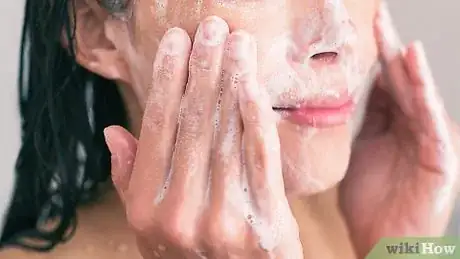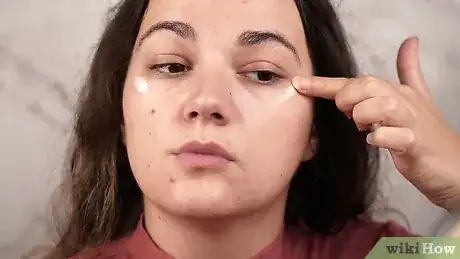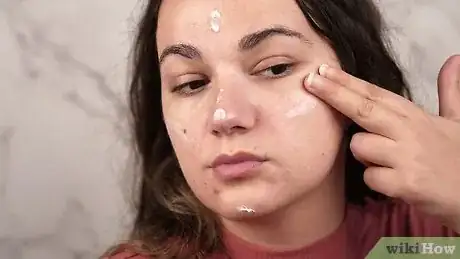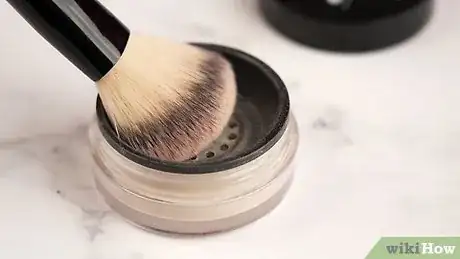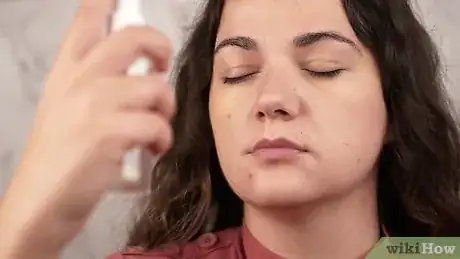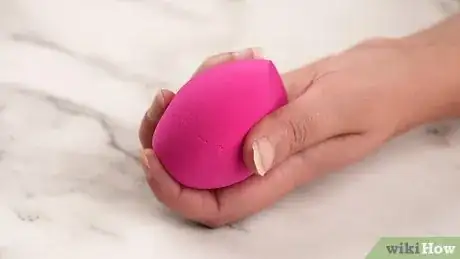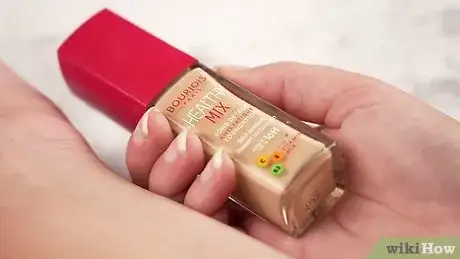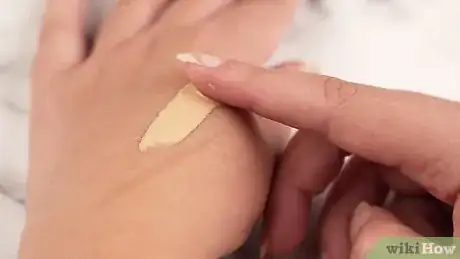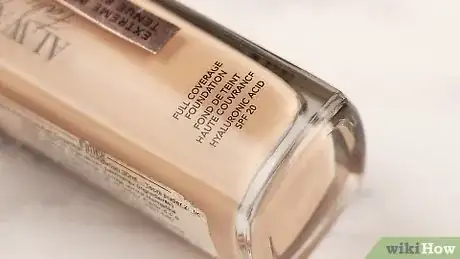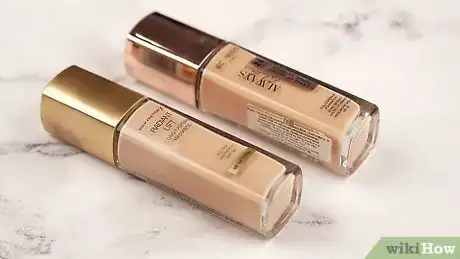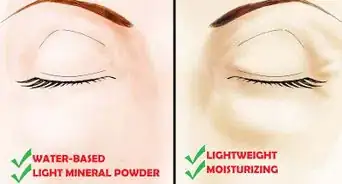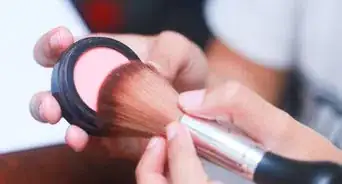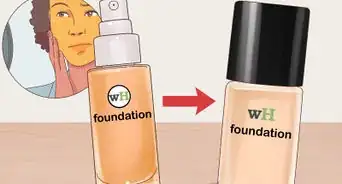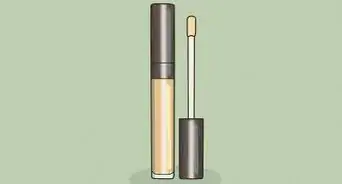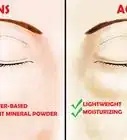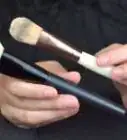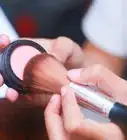This article was co-authored by Alicia D'Angelo and by wikiHow staff writer, Dan Hickey. Alicia D'Angelo is a makeup artist based in New York City. She currently works for teams with Dior Makeup, YSL Beauty and Pat McGrath Labs as well as bridal companies Once Upon A Bride and Miss Harlequinn. Her work has been featured in Today.com, New York Live, Forbes.com, VH1, MTV, Vevo, Entertainment Weekly, Refinery 29, and NYXCosmetics.com. She has a Visual Communications degree from FIDM-Los Angeles.
There are 18 references cited in this article, which can be found at the bottom of the page.
wikiHow marks an article as reader-approved once it receives enough positive feedback. In this case, 100% of readers who voted found the article helpful, earning it our reader-approved status.
This article has been viewed 996,181 times.
A great layer of foundation can make or break your makeup look, so what’s the best way to put it on? It turns out it’s not such a daunting task—once you’ve got the right tools and products, applying foundation is a straightforward process that only takes a few minutes. In this article, we’ll walk you through preparing your skin for smooth application, applying powder and liquid foundations, and selecting the perfect foundation for your skin and complexion. If you’re ready for that flawless, airbrushed look, keep scrolling!
Things You Should Know
- Wash and moisturize your face and apply primer before adding foundation. Clean, hydrated skin makes for a smooth and even foundation layer.
- Put on concealer before powder foundation. Use a fluffy brush to dab and blend powder from the middle of your face outward, then set with spray.
- Use a damp, egg-shaped sponge to dab and blend liquid foundation. Put on concealer afterward and set with powder.
Steps
Prepping Your Face
-
1Wash your face with lukewarm water and a mild cleanser.[1] Choose a face wash based on your skin type—use moisturizing washes for dry skin or oil- and alcohol-free washes for oily skin. Try ultra-gentle cleansers like micellar water for combination or sensitive skin.[2]
- Use an exfoliating scrub on your face 2-3 times per week. It removes dead skin cells from your pores and keeps your skin extra smooth.
- Regardless of what cosmetic products you plan to use, removing the dirt, oil, and impurities from your skin is the first step of applying makeup.
- Washing your face before putting on makeup makes your skin smoother and helps the makeup apply evenly.
-
2Apply a non-drying, alcohol-free toner. Saturate a cotton pad in toner and gently rub it all over your face to remove any last impurities on your skin. Wait a few seconds until the toner is almost fully dry before applying more products or cleansers.[3]
- Toner helps seal your pores and hydrate and refresh your skin.
Advertisement -
3
-
4Moisturize with a hydrating cream suitable for your skin type. If you have oily or acne-prone skin, choose a water-based, oil-free gel moisturizer. For dry skin, go for a thick moisturizing cream.[5] Lightly rub a thin layer all over your face, then gently press the moisturizer into your skin with your fingertips.[6]
- If you have sensitive skin, try a fragrance- and paraben-free moisturizer.
- People with normal or combination skin can use any type of moisturizer.
- Moisturizer softens and brightens the skin, makes foundation application easier, and helps your makeup stay on longer.
-
5Rub on a thin layer of facial primer after your moisturizer sets. Opt for a silicone-based primer—they protect your face from losing moisture and fill in the skin’s natural creases for more even makeup application. Apply a very thin layer all over your face (a pea-sized dot should be enough) and let it set for 1 minute.[7]
- Look for hydrating primers for dry skin or mattifying primers for oily skin.
- Water-based primers will moisturize your skin but don’t give you the skin-smoothing effects of silicone-based products.
-
6Color-correct dark circles or red spots that show through foundation. Foundation is meant to do light color-correcting, so you may not need to color-correct beforehand. If you need to cover something like noticeable acne, dark spots, or rosacea, though, apply a light layer of the appropriate color corrector to those spots and make sure to use at least a medium-coverage foundation afterward.[8]
- Correct light redness with green.
- Fix stubborn redness or rosiness with yellow.
- Use yellow or peach to correct brownish dark circles.
- Correct sallow or yellow areas with lavender.
- Use salmon (fair complexion), peach (light complexion), orange (medium complexion), or red (dark complexion) to fix dark undereye circles.
Adding Powder Foundation
-
1Apply liquid or cream concealers before powder foundation. Dab concealer over blemishes and your color-corrector, or paint upside down triangles underneath each eye to hide dark circles. Then, use your ring finger to dab and gently rub the concealer into your skin. The powder you’ll apply later will help set the concealer and keep it in place. [9]
- If you’d rather not use your fingers, use a concealer brush or beauty sponge instead.
- Applying cream or liquid concealers after a powder base might alter the coverage of your foundation.
-
2Grab a rounded, fluffy brush with densely-packed bristles. This style of brush lets you buff the powder into your skin for an even, blended look. Use a big, fluffy powder brush if you want very sheer or light coverage. Go for a bigger, denser brush (like a kabuki brush) or a powder puff for heavier coverage.[10]
- A denser brush puts on a slightly thicker layer of powder, which makes its pigments and coverage stronger.
-
3Swish the brush directly into the powder foundation. Dip the domed top of the brush into your powder and swipe it back and forth with quick, light strokes. Aim to distribute the powder evenly over the rounded dome shape—this will help with buffing and blending later.[11]
-
4Dot the foundation around your nose, upper cheeks, and forehead first. These are the spots that usually need the most foundation.[12] Make sure your brush is loaded with powder before you go in. To make a dot, gently press the dome of your brush into your skin and roll it around slightly—this makes an even circle of foundation that isn’t heavier in the center.[13]
- Examine other areas like your jawline or chin. If they have lots of concealer or color-corrector on them, dab a few foundation dots there, too.
- When the foundation dots are even, your final finish will be smooth and not cakey.
-
5Buff and blend the foundation dots for even, flawless coverage. Make quick, circular motions with your brush over each dot to buff them outwards. Use light pressure to stretch the product up toward your hairline and down toward your jaw and neck lines, continuing with your light circular movements.[14] Make sure your entire chin, forehead, nose, and cheeks are covered evenly. Dip the brush into the powder for more product if needed.[15]
- Let the brush do most of the work for you—just keep gently swirling the bristles over your face until the foundation is fully blended.
- If you need a little extra coverage in one spot, tap the brush into your skin to shake some more powder loose, then swirl it into your skin with your brush.
- The end result should look (and feel) seamless. Imagine the powder melting into your skin rather than sitting on top.
-
6Finish your foundation job with setting spray. Hold the can about 10 inches (25 cm) away from your face and spray in a circular motion. Then, use your palms to gently press it into your skin. The spray will hold your powder in place, plus it will smooth out the texture and make your face look more radiant.[16]
Adding Liquid Foundation
-
1Soak and squeeze an egg–shaped makeup sponge. Dip your sponge in clean water or run it under the faucet, then wring out all the excess water until it doesn’t drip any more. The sponge will almost double in size. This way, it won’t absorb your foundation and application will be smoother.[17]
- Use the same sponge to blend all of your cream makeup products or apply loose powder, too.
-
2Apply foundation to the damp sponge. Squirt or pump a small amount of liquid foundation on the back of your hand (or a blending plate) so it can spread out a little bit on a flat surface. Dab the sponge in it a few times so it has an even coat of foundation on it before applying to your face.[18]
-
3Tap small dots of foundation to the middle of your face first. Dab or bounce the sponge (never wipe or swipe) around your nose first, then move up and out toward your hairline—tap between the eyebrows, then move to the forehead. After, bounce the sponge down around your chin and jawline.[19]
- If you’re applying lip color, you can even use liquid foundation on your lips, too.
- The “bouncing” motion of the sponge is called stippling.
- As a general rule, you want to have more makeup near the center of your face than around the edges.
-
4Buff and blend around the eyes, nose, and neckline. Use the small, pointy tip of the sponge to stipple and buff the foundation around your nose and eyes until it’s evenly spread. Since your neck probably has a slightly different skin tone, bring the foundation about halfway down your throat to avoid a harsh line.[20]
-
5Apply concealer to cover blemishes, if needed. Wait until your foundation is set to add concealer—you probably won’t know exactly how much you need until you see the coverage you’ve got.[21] Dab blemishes and paint upside down triangles under your eyes with a concealer brush, then pat and blend it in with your ring finger.[22]
- If your foundation already covered your blemishes and evened out your complexion, you probably don’t need to add much (if any) concealer.
- Adding lots of concealer under your liquid foundation might make your final complexion look cakey (that’s why we lay down the foundation first).
-
6Set your foundation and concealer with setting powder. Use a small, fluffy brush to tap powder onto any shiny spots you notice on your face. Then grab a larger brush and stipple more powder onto larger areas of your face. Make light, circular motions with the brush to blend it all in.[23]
Choosing Foundation
-
1Select a color that matches your natural skin tone. In natural lighting, apply a dab of foundation near the center of your face and blend it out towards the hairline. Ideally, the shade should match the sides of your cheeks and the middle of your neck. If your neck is lighter than your face, choose a foundation that’s one shade lighter than your face.[24]
- If you end up with a shade that’s a bit too light for your complexion, apply bronzer to warm up your face.
- If you have a warm complexion, opt for a foundation with yellow undertones. If you have a cool complexion, look for products with pink undertones.
- Go one shade darker in the summer when your skin warms up from being outdoors in sunlight.
-
2Choose a foundation finish that will complement your skin type. Your skin’s natural tendency to build up oil or dry out during the day affects the final look of your foundation and how well it sticks to your face. Determine your skin type and then look for these finishes:[25]
- If you have oily skin, opt for a foundation with a matte finish. A dewy finish on oily skin tends to look too bright and shiny.
- If you have normal or dry skin, choose a moisture-rich foundation with a dewy finish to hydrate your skin.
- For combination or mature skin, use foundation with a satin formula finish. It has more dimension than dewy or matte and can hide unevenness.
-
3Use full-coverage foundation for discoloration and long wear. Full-coverage products don’t need midday touch ups and are great for hiding acne and discoloration in your complexion. If you don’t like wearing lots of makeup or have generally balanced and clean skin, go for a light coverage foundation or medium coverage foundation.[26]
- If you find your light or medium coverage foundation isn’t heavy enough, apply multiple layers to build it up.
- If you’re not sure what kind of coverage you need, go for a sheer foundation to start.
-
4Choose powder or liquid foundation based on your skin’s needs. Both types of foundation will cover your blemishes and even out your complexion. Powder is easier to reapply and goes on fast, whereas liquid lasts longer during the day. Consider these factors when deciding between products:[27]
- Powder is best for young, oily, or sensitive skin and those who sweat often.
- Liquid works great for older, drier, sun-sensitive, or acne-prone skin. It’s also more effective at masking wrinkles and deep lines.
- Feel free to mix powder and liquid foundations. Some people put on a liquid base and touch up shiny spots that need more coverage with powder.
Expert Q&A
Did you know you can get expert answers for this article?
Unlock expert answers by supporting wikiHow
-
QuestionWhat do I need to apply before foundation?
 Laura MartinLaura Martin is a Licensed Cosmetologist in Georgia. She has been a hair stylist since 2007 and a cosmetology teacher since 2013.
Laura MartinLaura Martin is a Licensed Cosmetologist in Georgia. She has been a hair stylist since 2007 and a cosmetology teacher since 2013.
Licensed Cosmetologist
-
QuestionHow do you apply liquid foundation?
 Laura MartinLaura Martin is a Licensed Cosmetologist in Georgia. She has been a hair stylist since 2007 and a cosmetology teacher since 2013.
Laura MartinLaura Martin is a Licensed Cosmetologist in Georgia. She has been a hair stylist since 2007 and a cosmetology teacher since 2013.
Licensed Cosmetologist
-
QuestionHow should I apply foundation?
 Laura MartinLaura Martin is a Licensed Cosmetologist in Georgia. She has been a hair stylist since 2007 and a cosmetology teacher since 2013.
Laura MartinLaura Martin is a Licensed Cosmetologist in Georgia. She has been a hair stylist since 2007 and a cosmetology teacher since 2013.
Licensed Cosmetologist
References
- ↑ https://www.healthshots.com/beauty/skin-care/7-must-do-things-before-you-put-on-make-up/
- ↑ https://www.vogue.in/content/how-to-pick-the-best-face-wash-based-on-your-skin-type
- ↑ https://www.healthshots.com/beauty/skin-care/7-must-do-things-before-you-put-on-make-up/
- ↑ https://www.healthshots.com/beauty/skin-care/7-must-do-things-before-you-put-on-make-up/
- ↑ https://www.masterclass.com/articles/types-of-moisturizers#5AjSj5hnfkZjEyCGVWbmAU
- ↑ https://www.healthshots.com/beauty/skin-care/7-must-do-things-before-you-put-on-make-up/
- ↑ https://www.cosmopolitan.com/style-beauty/beauty/a28916977/primer-makeup-benefits/
- ↑ https://www.elle.com/beauty/makeup-skin-care/a20633391/how-to-use-color-correcting-makeup/
- ↑ https://www.cosmopolitan.com/style-beauty/beauty/how-to/a32305/genius-concealer-hacks-every-woman-needs-to-know/
- ↑ https://hair-and-makeup-artist.com/makeup-brushes-face/
- ↑ https://hair-and-makeup-artist.com/makeup-brushes-face/
- ↑ https://www.cosmopolitan.com/style-beauty/beauty/how-to/a62357/how-to-apply-foundation/
- ↑ https://hair-and-makeup-artist.com/makeup-brushes-face/
- ↑ https://hair-and-makeup-artist.com/makeup-brushes-face/
- ↑ https://thestylingedit.com/how-to-blend-makeup
- ↑ https://www.cosmopolitan.com/style-beauty/beauty/a30122233/cakey-makeup-how-to-fix/
- ↑ https://www.masterclass.com/articles/how-to-apply-foundation-with-a-sponge
- ↑ https://www.masterclass.com/articles/how-to-apply-foundation-with-a-sponge
- ↑ https://www.health.com/beauty/apply-liquid-foundation
- ↑ https://www.masterclass.com/articles/how-to-apply-foundation-with-a-sponge
- ↑ https://www.realsimple.com/beauty-fashion/makeup/foundation-or-concealer-first
- ↑ https://www.cosmopolitan.com/style-beauty/beauty/how-to/a32305/genius-concealer-hacks-every-woman-needs-to-know/
- ↑ https://www.health.com/beauty/apply-liquid-foundation
- ↑ https://www.instyle.com/beauty/makeup/how-choose-foundation
- ↑ https://www.goodto.com/wellbeing/beauty/foundation-shade-finder-653390
- ↑ https://www.instyle.com/beauty/makeup/how-choose-foundation
- ↑ https://avalon.edu/2017/08/liquid-or-powder-foundation/
- ↑ https://www.masterclass.com/articles/tips-for-applying-flawless-foundation-from-bobbi-brown
- ↑ https://www.masterclass.com/articles/how-to-apply-foundation-with-a-sponge
- ↑ https://www.goodto.com/wellbeing/beauty/foundation-shade-finder-653390
- Videos provided by Jennifer Chiu
About This Article
To apply foundation, start by dabbing small dots of foundation on your nose, forehead, cheeks, and chin. Then, use a makeup sponge or brush to spread the foundation from the center of your face to the outer edges, including your hairline and jaw. Once your whole face is covered, blend the foundation in using the sponge or brush. Finally, lightly brush a setting powder over your face so your foundation stays in place for longer. If you want to learn more from our Cosmetologist co-author, like how to moisturize and prime your skin before you apply foundation, keep reading!
